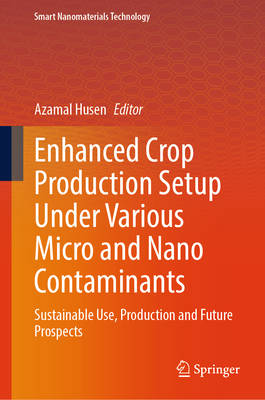
- Afhalen na 1 uur in een winkel met voorraad
- Gratis thuislevering in België vanaf € 30
- Ruim aanbod met 7 miljoen producten
- Afhalen na 1 uur in een winkel met voorraad
- Gratis thuislevering in België vanaf € 30
- Ruim aanbod met 7 miljoen producten
Zoeken
Enhanced Crop Production Setup Under Various Micro and Nano Contaminants
Sustainable Use, Production and Future Prospects
€ 305,45
+ 610 punten
Omschrijving
This book explores the uptake, toxicity, and tolerance of various contaminants in crop plants and discusses genetic and molecular methods, as well as biological tools, to improve plant growth under contamination stress. The book also covers defense mechanisms in plants using phytohormones and nanomaterials, along with safety concerns related to micro and nano-contaminants. Contaminants in soil-crop plant systems pose a significant challenge to sustainable agriculture, environmental health, and food security. These pollutants, such as herbicides, insecticides, fungicides, salts, nanomaterials, and toxic metals like cadmium, lead, mercury, and arsenic, can enter the food chain through contaminated soil and crops. These substances can damage plants, alter their growth processes, and compromise their integrity. As a result, the persistence of such chemicals within the ecosystem can remain unchanged, affecting plant health and soil quality. This book looks at the effective management practices for the use and disposal of contaminants that are essential to limit their harmful dynamics. It highlights the various interventions for the their tolerance and survival mechanisms of plants against contaminants that can disrupt morpho-physiological and biochemical. It also highlights the use of signaling molecules, phytohormones, plant nutrients, bioaugmented agents, and nanomaterials that can support plants in coping with contamination, improving growth and productivity. This book is a good resource for upper-level students, faculty, scientists, and researchers working especially in nanobiotechnology, plant biology, plant biochemistry, botanical or crop sciences, environmental sciences, ecological sciences, and other allied subjects and or science.
Specificaties
Betrokkenen
- Uitgeverij:
Inhoud
- Aantal bladzijden:
- 376
- Taal:
- Engels
- Reeks:
Eigenschappen
- Productcode (EAN):
- 9789819660988
- Verschijningsdatum:
- 31/10/2025
- Uitvoering:
- Hardcover
- Formaat:
- Genaaid
- Afmetingen:
- 156 mm x 234 mm
- Gewicht:
- 721 g

Alleen bij Standaard Boekhandel
+ 610 punten op je klantenkaart van Standaard Boekhandel
Beoordelingen
We publiceren alleen reviews die voldoen aan de voorwaarden voor reviews. Bekijk onze voorwaarden voor reviews.







